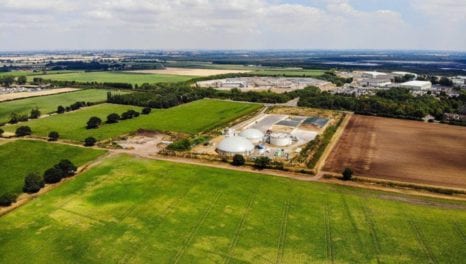CCC report outlines measures needed to achieve climate targets
The Committee on Climate Change (CCC) has outlined five priorities which would help cut emissions from the UK's housing stock.
21st February 2019 by Networks

In a new report ‘UK housing: Fit for the future?‘ the CCC warns that the UK’s legally-binding climate change targets will not be met without the near-complete elimination of greenhouse gas emissions from UK buildings. The report finds that emissions reductions from the UK’s 29 million homes have stalled, while energy use in homes – which accounts for 14% of total UK emissions – increased between 2016 and 2017.
According to the report, efforts to adapt the UK’s housing stock to the impacts of the changing climate: for higher average temperatures, flooding and water scarcity, are also lagging far behind what is needed to keep us safe and comfortable, even as these climate change risks grow. Around 4.5 million homes overheat, even in cool summers; 1.8 million people live in areas at significant risk of flooding; and average UK water consumption is higher than in many other European countries. Cost-effective measures to adapt the UK housing stock are not being rolled-out at anywhere near the required level, the report finds.
The report identifies five priorities for Government action:
1. Performance and compliance. The way new homes are built and existing homes retrofitted often falls short of stated design standards. This deceives householders and inflicts new costs in the future. Closing the ‘performance gap’ could save households in new homes between £70 and £260 in energy bills each year. In addition, widespread inspection and enforcement of building standards is needed, with stiffer penalties for non-compliance. The required further tightening of building standards will have little impact if these issues are left unresolved.
2. Skills gap. The chopping and changing of UK Government policy has led to a skills gap in housing design, construction and in the installation of new technologies. Important steps in reducing emissions are being held back as a result. The UK Government should launch a nationwide training programme and use initiatives under the Industrial Strategy’s Construction Sector Deal to plug this gap; by investing in new support to train designers, builders and installers of low-carbon heating, and measures to improve energy and water-efficiency, ventilation, thermal comfort and property-level flood protection.
3. Retrofitting existing homes. Ensuring existing homes are low-carbon and resilient to the changing climate is a major UK infrastructure priority, and must be supported as such by the Treasury. Homes should make use of low-carbon sources of heating such as heat pumps and heat networks. The uptake of energy efficiency measures, such as loft and wall insulation, must be accelerated. Upgrades and repairs to existing homes should include plans for shading and ventilation, measures to reduce indoor moisture, improved air quality and water efficiency and, in homes at risk of flooding, property-level flood protection.
4. Building new homes. New homes should be built to be low-carbon, energy and water efficient, and climate resilient. The costs of building to tight specifications are not prohibitive, and getting the design right from the outset is far cheaper than retrofitting later. From 2025 at the latest, no new homes should be connected to the gas grid. They should be heated using low-carbon energy sources, have ultra-high levels of energy efficiency alongside appropriate ventilation, and be timber-framed where possible. New laws are needed to reduce overheating risks in new buildings, as well as greater focus on ambitious water efficiency, property-level flood protection, green spaces (for example, trees on streets, vegetation on roofs, sustainable drainage systems) and provision for pedestrians, cyclists, public transport users and electric vehicle owners.
5. Finance and funding. There are urgent funding gaps which must be addressed, including secure UK Government funding for low-carbon sources of heating beyond 2021, and better resources for local authorities – particularly ‘building control’ departments. The UK Government must implement the Green Finance Taskforce recommendations around green mortgages, such as preferential rates for owners of energy-efficient and low-carbon homes and green loans to cover the upfront costs of home sustainability improvements. It should also look to widen the scope of these measures, for example including water efficiency, flood and heat resilience in ‘green building passports’, and resilience surveys – to flooding, for example – alongside energy ratings.
Householders can also make a big difference, even with small changes, the report shows. This includes setting boilers to the correct temperature, installing shading and increasing insulation, which helps to lower people’s energy bills and improve the comfort of our homes.
Baroness Brown, chair of the CCC’s adaptation committee, said: “This report confirms what we have long-suspected: UK homes are largely unprepared for climate change. The Government now has an opportunity to act. There must be compliance with stated building designs and standards. We need housing with low-carbon sources of heating. And we must finally grasp the challenge of improving our poor levels of home energy efficiency. As the climate continues to change, our homes are becoming increasingly uncomfortable and unsafe. This will continue unless we take steps now to adapt them for higher temperatures, flooding and water scarcity. Our report shows that this work has barely begun.
“Major improvements in how we design, build and use our homes are needed to meet these challenges. We have highlighted the need for appropriate sources of finance and funding – and a national training programme to ensure we have the building and construction skills required in the UK. Climate change will not wait while we consider our options – the nationwide shift we need to make UK homes climate-ready must start today.”
Lord Deben, Chairman of the Committee on Climate Change, said: “Simply put, there is no way in which the UK can meet the legally-binding climate change targets that Parliament has determined unless we take the measures outlined in this report.”
Industry reaction:
David Smith, chief executive of the Energy Networks Association, said: “The Committee on Climate Change has rightly highlighted the benefits that smart hybrid heating systems, energy efficiency and low carbon gas, like biomethane and hydrogen, can make in reducing emissions from our homes.
“Given the public benefits in decarbonising gas we therefore believe strongly that there is an enduring role for connecting energy efficient new homes to the gas grid beyond 2025 and that new homes should not be excluded from these opportunities.
“Gas network companies take their responsibilities to reduce carbon emissions seriously and are currently developing a set of pathways to decarbonise their networks. This includes a vital role for hydrogen. Decisions in the government’s heat roadmap will also help to provide electricity and gas networks with the certainty they need to deliver the low carbon transition at the lowest cost to the public.”
Chris Clarke, Wales & West Utilities energy strategy director, said: “It’s great to see the UK Committee on Climate Change endorse smart hybrid systems and hydrogen cities as a low regrets pathway to the full decarbonisation of heat – with a large scale roll out of smart hybrids on the gas grid as a first step.
“Smart hybrid systems like our Freedom Project will help us deliver a future energy system that is not only reliable and green, but also affordable – with research suggesting that they could reduce whole energy system costs by as much as £15bn per year compared to full electrification – making the best use of our existing energy networks, delivering low carbon gas and electricity. And critically, smart hybrid systems deliver this with little to no disruption to homes or communities, with limited behaviour change required from customers.”
Comments
Login on register to comment
Related content

Gas
Cadent backs launch of major bio-CNG HGV refuelling station
Gas network’s £250,000 infrastructure investment ensures supplies to existing connected customers have not been impacted

Gas
Editor’s blog: The biggest tests of resilience are yet to come
Network content director Jane Gray reflects on the industry's coronavirus response to date and the challenges still to come.

Gas
From the front line: Chris Garside and Andy Simcoe, Northern Gas Networks
Key workers across the power and gas networks are playing a critical role in the national response to Coronavirus. Network has committed to profiling their stories.
Related supplier content
![‘Learning by doing’ on the road to net zero [test product]](https://networksonline.s3.amazonaws.com/products/images/3.jpg)
People & Skills
‘Learning by doing’ on the road to net zero [test product]
DSO director Andrew Roper discusses 'Learning by doing'

Power
Load patterns and lockdown: how Covid-19 is impacting electricity networks
Insights into dynamics on the low voltage network as the outbreak unfolds

Downloads
Protect electrical equipment from insulation failure
Insulation faults are a major cause leading to the eventual failure of electrical equipment. Partial discharge (PD) is a very reliable indicator of developing insulation faults. Regular PD testing allows users to detect and analyze PD activity